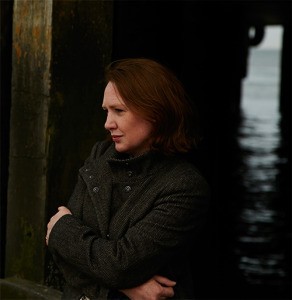Posted February 12, 2015
“The Girl On The Train”
By Paula Hawkins
By COURTNEY BARICH
Paula Hawkins brings several mind-boggling thoughts into the minds of the readers of her new novel “The Girl On The Train.” The novel questions the risks of jealousy and the power of memory.
 “The Girl On The Train” features an alcoholic divorcee named Rachel who spends most of the novel on the train riding to and from London. It is a fiery thrilling book that deals with disloyal and dysfunctional marriages.
“The Girl On The Train” features an alcoholic divorcee named Rachel who spends most of the novel on the train riding to and from London. It is a fiery thrilling book that deals with disloyal and dysfunctional marriages.
The novel is centered on trauma and the pain women encounter in their lives. It causes you to question whether you can ever fully trust yourself or your spouse.
Rachel rides the train every single morning and evening to and from London so that her roommate does not find out that she has been fired from her job.
Rachel is afraid that if her roommate finds out she has been fired from her job, she will think she is on a down-spiral and ask her to move out of the apartment. Rachel looks out the window of the train as it routinely passes the house she used to live in with her ex- husband. Not only is Rachel reminded of the life she used to live with Tom, but also that he currently lives there with Anna, the woman he left Rachel for, and their child.
 Paula Hawkins is a journalist from London who has worked in journalism for 15 years before writing her first fiction “The Girl On The Train.”
Paula Hawkins is a journalist from London who has worked in journalism for 15 years before writing her first fiction “The Girl On The Train.”
She was inspired to write the novel by her journeys back and fourth from college in London. Paula found herself wondering about the familiar strangers she passed on her daily commutes and wrote the thriller based on these thoughts.
Trying to keep busy, Rachel focuses on another home she passes on her train rides. She becomes oddly obsessed with this couple that she believes has a perfect relationship. She even goes so far as to name the couple Jessica and Jason and makes up their occupations, personalities, and day-to-day activities. One day she sees something shocking at the peaceful home she has revolved all her thoughts around and finds out later that the wife, Megan Hipwell, has gone missing.
Rachel, as unstable as she is, is unable to keep what she believes she saw to herself and goes to the police only to be told she is an unreliable witness. “I’m surprised by the fact that I don’t feel as awful as I might do. Thinking about it, I know why that is: I didn’t have a drink last night, and I have no desire to have one now. I am interested, for the first time in ages, in something other than my own misery. I have purpose. Or at least, I have a distraction.”
Rachel is thrilled by her role as a witness although she leaves us wondering how much she really saw from the train and if she can be trusted at all.
Rachel suffers daily with alcoholism and is forgetful of many of her nights causing her to feel unnecessary guilt and hurt. She narrates most of the story, blaming herself for many events that are not her fault:
“I lie down on the bed and crawl under the duvet. I want to know what happened; I wish I knew what I had to be sorry for. I try desperately to make sense of an elusive fragment of memory.”
She is constantly in pain and leaves herself and the reader unsure of what the actual source of the pain is.
Two troubled females narrate the other chapters of the story. Megan, the wife of the perfect couple, leads a life full of many secrets. She has been caught cheating, lying, and worse of all called a murderer. Anna, Tom’s present wife, seems to be an oblivious, controlled woman who deals with Rachel harassing her family daily.
Anna does not seem to understand the power she has forgone since she married Tom and how much of her time is consumed by Tom’s ex-wife. “I know Tom feels sorry for Rachel, but honestly I think it’s time I dealt with that bitch once and for all,” Anna says. Anna misses being Tom’s mistress but tries to lead a perfect life with her family.
All of the characters in the book have mischievous personalities. They each have very different motives and the narrators are not the most reliable. Through these characters, Paula Hawkins causes you to question yourself and the people around you. It is nearly impossible to stop thinking about who can be trusted and what the people surrounding you are thinking and doing.
The book causes you to become obsessed with its situation. It has a very astute pace and will compel you to keep flipping the pages until you reach the end. The truth about what happened to Megan does not come out until the very end. It is an incredible read and leaves the readers pondering if any of Rachel’s suffering was even her fault.
- Paula Hawkins “The Girl On The Train”
- Riverhead Books, Published by the Penguin Group
- Hardcover: $16.75, E-Book $8.99, Paperback $26.45
- ISBN 978-1-59463-366-9
- 323 pages
- Fiction
